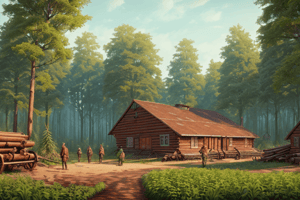Podcast
Questions and Answers
What was one of the main reasons for establishing the Indian Forest Service in 1864?
What was one of the main reasons for establishing the Indian Forest Service in 1864?
- To promote sustainable forestry practices
- To punish those who cut trees unlawfully (correct)
- To increase forest productivity
- To conduct scientific research on wildlife
Which year was the Indian Forest Act formulated?
Which year was the Indian Forest Act formulated?
- 1865 (correct)
- 1864
- 1906
- 1862
What type of forestry system was promoted by the Imperial Forest Research Institute?
What type of forestry system was promoted by the Imperial Forest Research Institute?
- Traditional forestry
- Natural forestry
- Community-based forestry
- Scientific forestry (correct)
What is one characteristic of plantations created by scientific forestry?
What is one characteristic of plantations created by scientific forestry?
What did forest officials do as part of scientific forestry management?
What did forest officials do as part of scientific forestry management?
How did scientific forestry alter the natural landscape?
How did scientific forestry alter the natural landscape?
When was the Imperial Forest Research Institute established?
When was the Imperial Forest Research Institute established?
What criticism do some ecologists have about scientific forestry?
What criticism do some ecologists have about scientific forestry?
What was one of the first actions taken by the forest department when logging an area?
What was one of the first actions taken by the forest department when logging an area?
What type of plantations were established on cleared natural forests to meet European demand?
What type of plantations were established on cleared natural forests to meet European demand?
Who was invited to provide expertise on forest management during British colonial rule in India?
Who was invited to provide expertise on forest management during British colonial rule in India?
What main concern drove the British government to manage the forests responsibly?
What main concern drove the British government to manage the forests responsibly?
What system was proposed to manage forests effectively under British rule?
What system was proposed to manage forests effectively under British rule?
Why were vast areas of natural forests given to European planters at cheap rates?
Why were vast areas of natural forests given to European planters at cheap rates?
What key action was emphasized by Brandis to ensure forest conservation?
What key action was emphasized by Brandis to ensure forest conservation?
What activity was restricted in forests to preserve them mainly for timber production?
What activity was restricted in forests to preserve them mainly for timber production?
What purpose did sleepers serve in railway construction?
What purpose did sleepers serve in railway construction?
Why did Britain seek timber resources from India in the early nineteenth century?
Why did Britain seek timber resources from India in the early nineteenth century?
How many sleepers were required per mile of railway track?
How many sleepers were required per mile of railway track?
What was the outcome of the massive tree felling in India during the expansion of the railways?
What was the outcome of the massive tree felling in India during the expansion of the railways?
What was the primary wood source for fuel needed for running locomotives?
What was the primary wood source for fuel needed for running locomotives?
What role did Adivasis play in the timber collection process?
What role did Adivasis play in the timber collection process?
What was the primary reason for the war that started in the region?
What was the primary reason for the war that started in the region?
Which of the following were the consequences faced by the villagers who supported the rebellion?
Which of the following were the consequences faced by the villagers who supported the rebellion?
What was one immediate reason for the demand for timber in India during the 1820s?
What was one immediate reason for the demand for timber in India during the 1820s?
By which year had the railway network in India expanded to about 25,500 km?
By which year had the railway network in India expanded to about 25,500 km?
What tactics did the adivasi leaders use to avoid confrontation during the battle?
What tactics did the adivasi leaders use to avoid confrontation during the battle?
What was a significant method of punishment used by the British against the rebellion participants?
What was a significant method of punishment used by the British against the rebellion participants?
Who were some notable supporters of the movement mentioned in the content?
Who were some notable supporters of the movement mentioned in the content?
What has been described as a characteristic of Gunda Dhur during the conflict?
What has been described as a characteristic of Gunda Dhur during the conflict?
What happened to the villages after the rebellion was suppressed?
What happened to the villages after the rebellion was suppressed?
How did the British troops respond to the attempts of the adivasi leaders to negotiate?
How did the British troops respond to the attempts of the adivasi leaders to negotiate?
What was the impact of colonial forest management on shifting cultivators?
What was the impact of colonial forest management on shifting cultivators?
Which of the following factors contributed to the decline of forest cover in the Indian subcontinent between 1880 and 1920?
Which of the following factors contributed to the decline of forest cover in the Indian subcontinent between 1880 and 1920?
What similarity exists between colonial forest management practices in Bastar and Java?
What similarity exists between colonial forest management practices in Bastar and Java?
What effect did the demand for tea and coffee plantations have on forest areas?
What effect did the demand for tea and coffee plantations have on forest areas?
Which group was primarily affected by the decline in forest cover due to commercial farming?
Which group was primarily affected by the decline in forest cover due to commercial farming?
During colonial rule, which activity was a major cause of deforestation related to shipbuilding?
During colonial rule, which activity was a major cause of deforestation related to shipbuilding?
What role did British officials engaged in shikar play in forest management?
What role did British officials engaged in shikar play in forest management?
How did nomadic and pastoralist communities respond to colonial forestry policies?
How did nomadic and pastoralist communities respond to colonial forestry policies?
Flashcards are hidden until you start studying
Study Notes
Forest Society and Colonialism
- British Colonialism and Forests: The British, seeking timber for Royal Navy ships and railway sleepers, began exploiting Indian forests in the 1820s.
- The Expansion of Railways: The 1850s onwards saw rapid railway development, creating a significant demand for timber due to fuel and sleeper requirements. By 1946, railway tracks in India expanded to over 765,000 km.
- The Impact of Forestry: The growing demand for timber and railway expansion led to a large-scale felling of trees across India. This resulted in widespread deforestation and environmental changes.
- Impact of Commercial Forestry: European demands for tea, coffee, and rubber created a need for plantations, leading to the clearing of vast areas of natural forests, a practice that continues today.
- Scientific Forestry: Introduced by Dietrich Brandis, the first Inspector General of Forests in India, "Scientific Forestry" sought to manage forests for timber production. It involved replacing natural forests with plantations of a single tree species.
- Opposition to Colonial Forestry: Indigenous communities, particularly Adivasis, protested against the colonial government's control over forests and their exploitation.
- The Role of Adivasis: Adivasis, a large indigenous group in India, were often displaced and denied access to their ancestral forests. They were forced to work for the colonial forest department and lost their traditional livelihoods due to the changes in forest management.
Environmental Change
- Forest Cover Decline: Between 1880 and 1920, India's forest cover decreased by 9.7 million hectares, highlighting significant deforestation during the colonial era.
Colonial Impact
- Shifting Cultivators: The demand for timber and expansion of plantations displaced shifting cultivators, impacting their traditional agricultural practices.
- Nomadic and Pastoralist Communities: Nomadic and pastoral communities faced restrictions on grazing, disrupting their traditional livelihoods.
- Timber/Forest Product Trading Firms: Colonial forestry laws favored timber and forest product trading firms by regulating access to forest resources.
- Plantation Owners: European planters were given vast areas of land at low costs, leading to the expansion of tea, coffee, and rubber plantations.
- Kings/British Officials Engaged in Shikar: Hunting activities, particularly by British officials, put pressure on wildlife populations.
- Adivasis and other Peasant Users: Adivasis and other peasant users faced strict forest regulations, limiting their access to forest resources for traditional needs.
- Similarities in Colonial Management: Colonial forest management in Bastar and Java shared similarities in their focus on maximizing timber production and the displacement of local communities.
Studying That Suits You
Use AI to generate personalized quizzes and flashcards to suit your learning preferences.




